
|
Sale 69
The May Pre-Long Beach Auction
| Lot |
Photo |
Description |
Realized |
Lot 3000 |
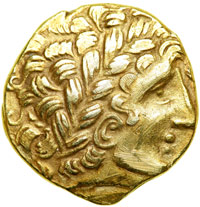 |
Celtic Gaul. Rennes Region (Bretagne). Gold Stater (7.72 g) struck c. 2nd century BC. Laureate head right of Apollo. Reverse: Naked female on horseback right, holding shield and brandishing spear; above, stars; below; musical instrument; to right, wheel. BN 6757. Well centered and unusually well struck. Extremely Fine and exceedingly rare.
The rider on this revrese type is commnoly identified as Epona, but, as a protectress of horses, a fertility goddess, and a leader of souls into the afterlife, Epona is usually depicted elsewhere in Celtic art with attributes such as the patera and cornucopiae rather than weaponry. The warrior-queen advancing into battle was, however, a popular theme in Celtic legend, and may well be represented here.
Estimated Value $40,000 - 50,000.
View details and enlarged photos
| Unsold |
Lot 3001 |
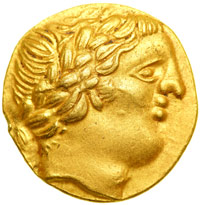 |
Celtic Gaul. Gironde Region (Southwestern Gaul). Gold Stater (8.5 g) struck c. 300-150 BC. Pons/Sainte Eanne Series. Stylized head right of Apollo with protruding forehead and jaw. Reverse: Fast biga right; below, trident. Sills 9. DT 3612; Castelin 370. Virtually as struck. Extremely Fine and very rare.
Estimated Value $4,000 - 5,000.
View details and enlarged photos
| Realized
$5,750 |
Lot 3002 |
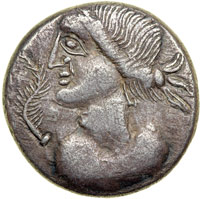 |
Celtic Central Europe. Slovakia. Boii. Busu. AR Hexadrachm (16.91 g) struck c. 2nd century BC. Diademed male bust left; to left, palm branch. Reverse: BVSV; winged female centaur left, head right. Cast. 1161; BN 10141; Paulsen 786; Allen-Nash 84. See Paulsen pp. 88-89 for source of prototype. A remarkable example of this intriguing coin. Very Fine and extremely rare.
The Attic weight tetradrachms of the "Biatec" series are often referred to as hexadrachms, given the contrast in weight with the comparatively light tetradrachms struck contemporaneously in the Celtic world. Their size and purity are testament to the prosperity of the Boii on the eve of Roman domination of the region. The reverse motifs of the series are mostly fabulous beasts; the winged centauress of the present type is perhaps the most original.
Estimated Value $8,000 - 9,000.
From the Garrett Collection Part II (Johns Hopkins University) Leu/NFA Zurich (Oct. 16-18, 1984) lot 66 (realized 6250 SF); Previously: JWG, Schulman I. April 1927; Sotheby Auction 12. Feb. 1923 (Sandars), 142.
View details and enlarged photos
| Realized
$12,650 |
Lot 3003 |
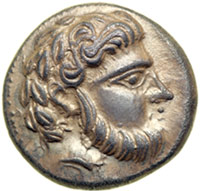 |
Celts in Eastern Europe. Dacian Plain, c. 3rd Century BC. AR Tetradrachm (13.98 g). Baumreiter type. Laureate and bearded head of Zeus right. Reverse: Horseman riding left, wearing crested helmet, holding palm branch, animal device to left, leaf ornaments below. Göbl, OTA 129; CCCBM I 67; Dessewffy 775. Struck in high relief with delicate golden toning. A stunning Celtic tetradrachm. Superb Extremely Fine.
The geographical range of this coinage is rather broad and includes both the Dacian plain and southern area of Serbia.
Estimated Value $4,000 - 5,000.
View details and enlarged photos
| Realized
$4,370 |
Lot 3004 |
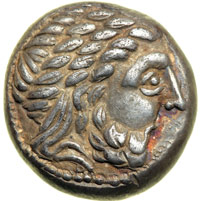 |
Celts in Eastern Europe, c. 3rd-2nd Century BC. AR Tetradrachm (14.36 g). Zangenlorbeer type. Laureate and bearded head of Zeus right. Reverse: Crested horseman, prancing left, holding two birds overhead, wavy exergual line. Göbl, OTA 163/1 (these dies); Dembski 1102 (these dies); Cf. Kostial 446 (one bird). Rare and nicely toned. Extremely Fine.
The tetradrachms of northern Serbia assimilate various subtypes utilized in the eastern Danubian region, often combining previously unassociated obverse and reverse varieties. The dies tend to be neatly engraved and the coins struck on thick flans.
Estimated Value $3,500 - 4,000.
Ex Leu 79, Oct. 31, 2000, lot 128; Peus 329, Oct. 31, 1990, lot 17.
View details and enlarged photos
| Realized
$3,565 |
Lot 3005 |
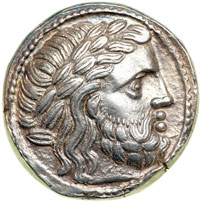 |
Celts in Eastern Europe. Pannonia, c. 1st Century BC. AR Tetradrachm (14.06 g). Laureate head right of Zeus. Reverse: Youth on horse prancing right. Cf. Le Rider plate 48. Some luster remaining. Extremely Fine.
Imitative of tetradrachms of Philip II of Macedon.
Estimated Value $1,000 - 1,200.
View details and enlarged photos
| Realized
$834 |
Lot 3006 |
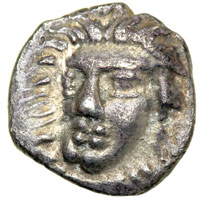 |
Campania, Phistelia, Fourth Century BC. AR Obol (0.55 g). Head (nymph or Apollo?) three-quarter facing to left. Reverse: Lion walking left; in exergue, coiled snake [off flan]. SNG ANS 584-589; Dewing 113-114. Choice Very Fine.
This denomination was commonly used in the fish markets of Magna Graecia.
Estimated Value $150 - 200.
View details and enlarged photos
| Realized
$144 |
Lot 3007 |
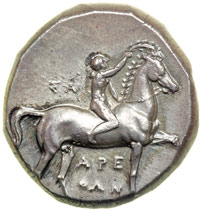 |
Calabria, Taras, 302-281 BC. AR Nomos (or Didrachm; 7.91 g). Boy riding right, crowning prancing horse. Reverse: Taras holding tripod, astride dolphin left; in upper right field, ethnic. Cf. Vlasto 666 (but different dies). Well modeled and beautifully toned. Extremely Fine.
Estimated Value $500 - 600.
View details and enlarged photos
| Realized
$633 |
Lot 3008 |
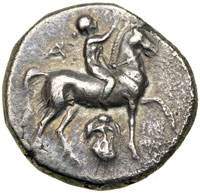 |
Calabria, Taras, c. 272-235 BC. AR Nomos (or Didrachm; 6.3 g). Boy riding right, crowning prancing horse; bearded mask below. Reverse: Taras, holding kantharos, astride dolphin left; in upper right field, ethnic. Vlasto 859. SNG ANS 1189. Lightly toned. Very Fine.
Estimated Value $250 - 300.
View details and enlarged photos
| Realized
$288 |
Lot 3009 |
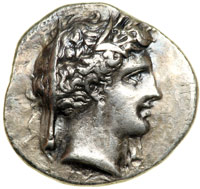 |
Lucania, Metapontion, c. 350 BC. AR Stater (7.37 g) engraved by the artist Aristoxenos. Wreathed and veiled head right of Demeter. Reverse: Ear of barley with bird on leaf; in left field, ethnic; in lower left field, artist's "ARI". Cf. SNG ANS 415; cf. Dewing 381. Smoothed a bit. Very rare. About Extremely Fine.
A beautiful example of a coin of high style by the artist Aristoxenos.
Estimated Value $1,200 - 1,500.
View details and enlarged photos
| Realized
$920 |
Lot 3010 |
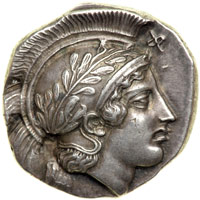 |
Lucania. Thourioi, c. 443-400 BC. AR Stater (7.99 g). Head of Athena right in crested Attic helmet adorned with olive wreath; above visor, phi. Reverse: Bull walking left with head lowered; on rump, phi; below, small bird taking flight; in exergue, tunny fish left. SNG Ashmolean 899 (same dies); SNG ANS 948 (same obv. die); Kraay-Hirmer 251 (same obv. die). The quality is superb, the toning delightful and the dies are rare. A simply magnificent Thurian stater. Superb Extremely Fine.
This coin is sometimes attributed to Phrygillos, the famous coin and gem engraver, and the bird on the reverse has been considered a pun on his name. Phrygilos in Greek means finch.
Estimated Value $20,000 - 30,000.
Ex Leu 81 (16 V 2001), lot 26. Prior: Nelson Bunker Hunt Coll. (Sotheby's, 21 VI 1990), lot 204; NFA X (17 IX 1981) lot 19; Bank Leu 25 (23 IV 1980), lot 38.
View details and enlarged photos
| Realized
$29,900 |
Lot 3011 |
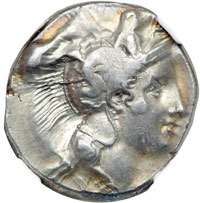 |
Lucania, Thourioi, c. 350-300 BC. AR Stater (or Nomos; 7.85 g). Head of Athena right, wearing crested Attic helmet. Reverse: Bull butting right, Thourioi above; in exergue, dolphin. SNG Cop 1440. Struck from a worn obverse die, strong reverse. Lightly toned. NGC graded XF; Strike: 2/5, Surface: 5/5.
Estimated Value $300 - 350.
View details and enlarged photos
| Realized
$483 |
Lot 3012 |
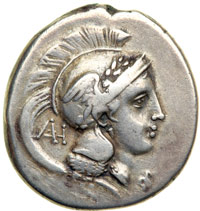 |
Lucania, Velia. 400-350 BC. AR Didrachm (7.30 g). Head of Athena right wearing crested helmet decorated with griffin; behind, AI monogram and phi (probably the signature of an engraver) below chin. Reverse: Lion walking right, corn-ear above; ethnic below exergual line. SNG Cop 1578. Lightly toned. Very Fine.
Estimated Value $250 - 300.
From a Münzen & Medaillen Deutschland Sale, lot 403.
View details and enlarged photos
| Realized
$426 |
Lot 3013 |
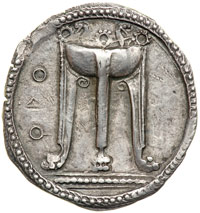 |
Bruttium, Kroton, 530-500 BC, AR Stater (6.43 g). Tripod with two serpents emerging from bowl. Reverse: Same type, incuse. Cf. SNG ANS 227-237. NGC Photo-Certificate, graded XF*; Strike 5/5; Surface 5/5; Fine Style. Our grade is VF-EF on a large, early flan.
This coin is about 1.5 grams light, which could be accounted for by internal porosity, utilization of an earlier-struck coin, or just a slight reduction of the weight standard. The ANS examples range from 7.32 to 8.83 grams.
Estimated Value $1,200 - 1,600.
Ex Superior's 29 V 91 sale, lot 2003.
View details and enlarged photos
| Realized
$2,645 |
Lot 3014 |
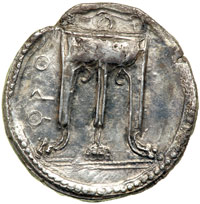 |
Bruttium, Kroton, c. 500-480 BC. AR Stater (7.96 g). An alliance issue with Temesa, circa 500 BC. Tripod with legs ending in lion's feet, and with three handles and snakes rising from the bowl; cable border. Reverse: Crestless Corinthian helmet to left, incuse; rayed border. Basel 204; HN III 2096; Kraay, ACGC 618. Extremely rare, the third known example. Toned and well struck. Choice Very Fine.
While the author of HN III does not consider this coin to be an alliance issue (and says nothing about the later double reverse type - HN III 2122-2124) this seems unlikely. The appearance of such an unusual type, and the fact that the letters TE are on the obverses of the later staters, makes it certain that we are dealing with a special issue, unlike the widespread eagle reverse pieces.
Estimated Value $35,000 - 45,000.
Ex Nomos Auction 5 (Zurich), lot 108; previously from a New York collection.
View details and enlarged photos
| Unsold |
Lot 3015 |
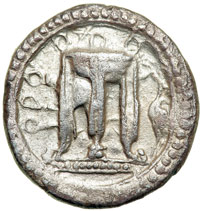 |
Bruttium, Kroton, c. 480 BC. AR Third Stater. Delphic tripod with three handles, and legs terminating in lion's feet; ethnic to left, stork standing to right of tripod. Reverse: Delphic tripod incuse. BMC 27; SNG ANS — (unlisted type); cf. SNG Cop 1757. Rare. A little porous. Unusually large and round flan. Choice Very Fine.
A classic issue of the archaic coinage minted in Magna Graecia. An excellent example of a fractional silver coin, actually less often seen than the full stater, at a fraction of the price.
Estimated Value $500 - 600.
View details and enlarged photos
| Realized
$506 |
Lot 3016 |
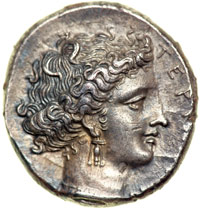 |
Bruttium, Terina. AR Nomos (7.55 g) struck c. 380 BC. Head right of the nymph Terina. Reverse: Nike wearing sleeveless chiton, hair in sphendone, seated left on square cippus, holding bird. Kraay-Hirmer 277; Regling (Terina) 79 (same dies); SNG ANS 853 (same dies). An extraordinary coin struck in high relief on both sides! Beautiful old cabinet toning. Superb Extremely Fine.
Estimated Value $15,000 - 20,000.
Ex New York Sale XI (Jan. 2006), lot 29.
View details and enlarged photos
| Unsold |
Lot 3017 |
 |
Sicily, Adranon, c. 344-336 BC. AE Litra (28 mm). Laureate head left of Apollo. Reverse: Kithara. Calciati III, p. 157, 1. Rare. Very Good to Fine.
The kithara was a technologically advanced lyre, having a sound box. The ancient Greeks employed over two hundred modes or scales (today we use only the major and minor ones for most all music). They believed that each mode affects the listener differently. So does the present writer.
Estimated Value $150 - 200.
View details and enlarged photos
| Unsold |
Lot 3018 |
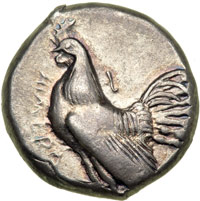 |
Sicily, Himera, c. 483-472 BC. AR Didrachm (8.26 g). Rooster standing left; ethnic in left field. Reverse: Crab within circular border. SNG ANS 158. Underlying luster still evident. Nicely toned and well detailed. Superb Extremely Fine.
The selection of a Greek city-state's coin type often reflected some important local crop. A "type parlant," or punning allusion to the city's name, could also be chosen. Here, the Greek word for "day" is identified with the first sound of the ancient day — the herald of the rooster.
Estimated Value $4,000 - 5,000.
View details and enlarged photos
| Realized
$2,990 |
Lot 3019 |
 |
Sicily, Kentoripai, After 241 BC. AE Dekonkion (AE 24.50 mm). Laureate head right of Zeus; behind, eagle. Reverse: Winged thunderbolt; delta underneath. SNG ANS 1307-1315; BMC 3. Glossy dark green patina. Superb Extremely Fine.
Struck in high relief for bronze coinage.
Estimated Value $400 - 500.
View details and enlarged photos
| Unsold |
Lot 3020 |
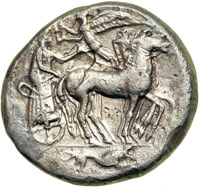 |
Sicily, Leontinoi, 470-465 BC. AR Tetradrachm by the Demareteion Master. Slow quadriga right, charioteer crowned by Nike; lion running in exergue. Reverse: LEOTINO, laureate head of Apollo right of superb late archaic style; three bay leaves around; lion running below right. SG 823; BMC 14; SNG ANS 217; Gulbenkian 211; Randazo 89; Dewing 623 (all from the same dies). Details are Very Fine with some porosity and flan faults, all toned, die break beginning at ear. One of the icons of ancient Greek coinage. About Very Fine.
Leontinoi was founded by the Chalkidians from Naxos in 729 BC. Leontinoi produced no coinage in the Archaic period. In the early part of the 5th century BC, the city was under the rule of the Gelan and the Syracusan tyrants, but in 466 BC it regained its independence. This coinage was probably struck to celebrate this event.
Sear notes, "This masterpiece of late archaic art is probably by the same hand as the famous 'Demaretion' coinage of Syracuse." It has been suggested that the effigy of the lion on this coin as well as the lion on the Demareteion dekadrachm are marks of the master engraver.
Estimated Value $7,000 - 8,000.
Private purchase from Realms in 2005.
View details and enlarged photos
| Unsold |
Lot 3021 |
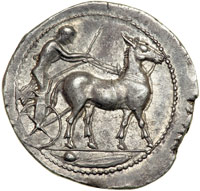 |
Sicily, Messana, c. 425-421 BC. AR Tetradrachm (17.45 g). Biga of mules driven right by city goddess Messana; in exergue, an olive leaf and berry. Reverse: Hare bounding right; below, fly. Caltabiano 479 (these dies); SNG ANS 375 (these dies). Traces of mint luster underlying old cabinet toning. Superb Extremely Fine.
In addition to Philip II of Macedon being victorious in the ancient Greek Olympic Games, another ruler, the tyrant Anaxilas of Messana, was a winner. In 480 BC, Anaxilas drove his mule team to place in the event.
Estimated Value $17,000 - 20,000.
View details and enlarged photos
| Realized
$15,525 |
Lot 3022 |
 |
Sicily, Messana, c. 412-408 BC. AR Tetradrachm (17.17 g). Biga of mules driven left by city goddess Messana; in exergue, two dolphins face to face. Reverse: Hare bounding left; above, bird flying left; beneath, grain ear; below exergual line, ethnic. Caltabiano 622 (these dies); Pozzi 1094; SNG Lockett 831. Wonderful detail from fresh dies. Superb Extremely Fine.
Estimated Value $20,000 - 25,000.
View details and enlarged photos
| Realized
$18,400 |
Lot 3023 |
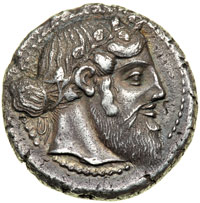 |
Sicily, Naxos, c. 460 BC. AR Tetradrachm (16.42 g). Bearded head of Dionysos right, wearing wreath of ivy, hair tied in bunch behind head. Reverse: N-AXI-ON, nude and ithyphallic Silenos squatting facing, head left, holding kantharos in right hand, leaning on left. Cahn 54; SNG ANS 515; SNG Lloyd 1150; SNG Lockett 840; Gulbenkian 230-231; Rizzo pl. 28, 2; Jenkins 673; SNG Fitzwilliam 1108; Kraay-Hirmer 6 (all references same dies). Nicely toned, some light porosity with a small spot of horn silver below Selinos slightly smoothed. Struck from an earlier die state with no trace of the die break under the nose. One of the most celebrated coins from antiquity, a masterpiece of engraving. Choice Very Fine.
Naxos was the earliest of the Greek colonies in Sicily, having been founded around 735 BC by settlers who probably had originated from the Aegean islands. In addition, Naxos was the mother-city of the celebrated Sicilian communities of Leontini and Katana. In 476 BC, the entire population of Naxos was moved to Leontini by Hieron of Syracuse. They evidentally returned home some fifteen years later in 461 BC. It appears that this tetradrachm probably was struck to celebrate this event. This issue was struck from only one pair of dies, and is considered one of the true masterpieces of Greek art. Only about 75 examples of this important coinage are known to exist. The first example of the art of foreshortening.
As noted in the Hunt Auction Catalog:
The obverse is a superb head of Dionysus, engraved with a mastery and power equaled only by the unique tetradrachm now in Brussels of Aetna (the new name of Catana) with its head of Silenus; the similarity is so great and the artistry so exceptional that it is thought that both dies were the work of a single artist, the so-called Aetna Master. Here, for example, the way that the hair and beard overlap the surrounding circle enhance the sculptural quality of the head and give it extra depth. The reverse of the Naxian coin shows an equal triumph of the coin engraver's art; the stunning conception of the frontal view of a squatting Silenus, companion of Dionysus, and the technical brilliance of the engraving of the foreshortening limbs and muscles have no equal in Greek coinage.
Estimated Value $80,000 - 100,000.
Ex: Triton VIII (Jan. 2005), lot 70; Ronald Cohen Coll. Gorny & Mosch 112 (Oct. 2001), lot 4028; Nelson Bunker Hunt Collection IV (Sotheby's, June 1991), lot 79.
View details and enlarged photos
| Unsold |
Lot 3024 |
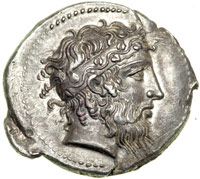 |
Sicily, Naxos, c. 425-415 BC. AR Tetradrachm (16.74 g). Head right of Dionysos, hair bound with taenia ornamented with ivy. Reverse: Silenos squatting, head left, holding kantharos and thyrsos; to left, ivy plant. Cahn 100 (plate V, V66/R82; these dies); Gulbenkian 232 (these dies); Jameson 677 (these dies); SNG München 761 (these dies); SNG Fitzwilliam 1113 (these dies). Large flan with underlying luster and lovely toning. Superb Extremely Fine.
Naxos was the oldest Greek colony on the island of Sicily. It was located on the east coast of the island, close to modern Taormina. In 404 BC, the city was razed by the tyrant Dionysos of Syracuse, so her coinage was quite limited. In fact, for this type, we know of only one obverse die being paired with five different reverse dies. Our coin is one of the very finest specimens known, struck upon an unusually large flan. The two casting spurs are prominent; each flan was first cast, adjusted for proper weight, then struck between hardened dies. The strength of strike was considerable, making every lock of hair clearly defined.
For decades now, more and more collectors have turned their eyes to the past. They hear the voices, and now and then, the music. History needs time to achieve a proper perspective and a more unbiased overview. Generations of numismatists, while reminding us that each and every coin has its story to tell, have grouped the most historical, the earliest, the rarest and, importantly, the most beautiful and inspiring Greek coins.
While these artistically compelling coins include those minted at Amphipolis and other city-states, a majority of the finest designs ever conceived and created were minted in Sicily. This particular tetradrachm we now offer is one of those coins - an unforgettable, first-water treasure of numismatic art.
Estimated Value $200,000 - 250,000.
Ex Triton X (1/6/09), lot 79.
View details and enlarged photos
| Unsold |
Lot 3025 |
 |
Sicily, Panormos, c. 370-360 BC. AR Tetradrachm (17.1 g). High action quadriga galloping left driven by charioteer crowned by Nike flying right; charioteer holds goad in right hand, reigns in left with sign of Tanit between. Reverse: Female head right, of fine style, wearing ampyx; dolphins around. SG 891; Jenkins "Coins of Punic Sicily, Part 1" plate 10, 39 (same dies); Weber 1476 (same dies). Some weakness around the borders and exergue. Struck on a nice large flan and delicately toned. Very rare. Very Fine/Extremely Fine.
Copied from the coinage of Syracuse.
Estimated Value $3,000 - 3,500.
Ex Gorney & Mosch, A-134 (Oct. 2004), lot 1134.
View details and enlarged photos
| Unsold |
Lot 3026 |
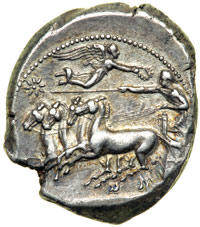 |
Sicily, Panormos, c. 340-320 BC. AR Tetradrachm (17.0 g). Quadriga galloping left, guided by charioteer in long chiton; above, Nike flies to crown charioteer; above horses' heads, star. Reverse: Female head left, wreathed with corn, surrounded by dolpins. SNG ANS (Sicily Part 2) 542 (same dies); Jenkins, "Coins of Punic Sicily, Part 1" plate 13, 71 (same die). Struck slightly off-center, with lovely antique toning. Very rare. Extremely Fine.
Estimated Value $2,500 - 3,000.
Ex Gorny & Mosch, A 133 (Oct. 2004) lot 82.
View details and enlarged photos
| Unsold |
Lot 3027 |
 |
Sicily, Syracuse, c. 460-440 BC. AR Tetradrachm (17.4 g). Quadriga pacing right; Nike flies to crown the horses; the charioteer holds a goad in his right hand and the reins in his left. Reverse: Head of Arethusa right, wearing a ring and crescent earring, and a pearl necklace; her hair is bound with a cord down to which it falls from the crown in heavy locks, and over which it is tucked in from the ear backwards, with a row of luxuriant curls along the forehead. Gulbenkian 264; Boehringer 537; SNG ANS 174; Dewing 805. Excellent metal and exceptional style, all delicately toned. Very rare. Extremely Fine.
Estimated Value $5,000 - 6,000.
Purchased from Realms, 2005.
View details and enlarged photos
| Realized
$7,188 |
Lot 3028 |
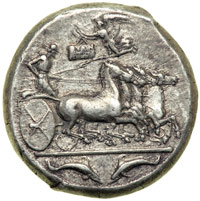 |
Sicily, Syracuse, c. 410 BC. AR Tetradrachm (17.43 g). Signed by Euainetos and Eumenos. Signed on the obverse by Euainetos and on the reverse by Eumenos. Galloping quadriga right, above Nike flying left carrying tablet with artist's signature Euainetos; two dolphins, nose to nose in exergue. Reverse: Head of Arethusa left, wearing ampyx and sphendone, artist's signature Eumenos under neck truncation, four dolphins around. Tuder 44 (14/26); Rizzo pl. xliii, 8 (same dies). Excellent metal and nicely toned. A lovely problem-free example of this classic rarity. About Extremely Fine.
On this, his second obverse die for Syracuse, Euainetos sought recognition by making his signature more conspicuous. He inscribed his name on a tablet, as Eukleidas had already done, but cleverly incorporated it into the scene by placing it in Nike's hands, where we might expect to find the name of the victorious charioteer. Very Rare and one of Euainetos' best work.
Estimated Value $20,000 - 24,000.
Purchased from Antiqua, Dec. 2003.
View details and enlarged photos
| Unsold |
Lot 3029 |
 |
Sicily, Syracuse, c. 410 BC. AR Tetradrachm. Signed on both sides. Signed on the obverse by Eu… and on the reverse by Eukleidas. Galloping quadriga driven left; above, Nike flying right to crown driver; artist's signature EY under horses. Reverse: Head of Arethusa left, artist's signature Eukleidas on tablet beneath chin, four dolphins around. Tudeer 30 (11/16); Rizzo pl. xlii, 16 (same dies), also pl. XIV, 1 and pl. XLVI, 1 (reverse enlargements.). Choice Very Fine.
Eukleidas is most celebrated for his facing head of Athena c. 405 BC. This, his first signed die at Syracuse, shows that he initially worked under the strong influence of Eumenos. But his Arethusa is slightly more finely featured, with smaller eye, more delicate nostrils, and thinner lips. Very Rare and much sought-after.
Estimated Value $10,000 - 12,000.
From Antiqua XII, 12/2003, #30.
View details and enlarged photos
| Unsold |
Lot 3030 |
 |
Sicily, Syracuse, 405-400 BC. AR Dekadrachm by Euainetos (unsigned). Charioteer driving galloping quadriga left, holding goad in right hand, reins in left; Nike flying above and crowning driver; below, military harness, shield, greaves, cuirass and Attic helmet, connected by horizontal spear. Reverse: Wreathed head of Persephone left wearing triple-pendant earring and necklace, surrounded by four dolphins (two not on flan); delta below chin. Gallatin obv. R X/rev. D.1; SNG ANS 371 (same dies); Dewing 901 (same dies). Excellent metal with no obverse die rust; light die rust on reverse. Flat strike on highest points. Extremely Fine.
Estimated Value $35,000 - 45,000.
Private purchase from Realms in 2005.
View details and enlarged photos
| Unsold |
Lot 3031 |
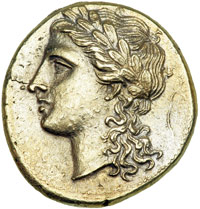 |
Sicily, Syracuse. Agathokles, 317-289 BC. Electrum 25 Litrai (3.52 g). Laureate head left of Apollo; behind, bow. Reverse: Tripod-lebes. Jenkins (Essays Robinson) Group C, plate 15 (these dies not shown); Boston MFA 447. Struck from badly rusted dies. Moderate flan crack, as often seen. Otherwise Extremely Fine.
This coin (same weight) is often catalogued as a 50 litrai denomination. The gold content is approximately 47%.
Estimated Value $2,000 - 2,500.
View details and enlarged photos
| Unsold |
Lot 3032 |
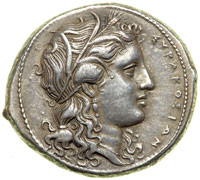 |
Sicily, Syracuse. Agathokles, 317-289 BC. AR Tetradrachm (17.05 g) minted c. 305-300 BC. Head right of Persephone-Kore wreathed with grain. Reverse: Nike standing right erecting trophy; in right field, triskelion. Jameson 865; SNG ANS 669; BMC 378. The obverse die is of the finest classical styl Extremely Fine/Choice Very Fine.
Estimated Value $5,000 - 5,500.
View details and enlarged photos
| Realized
$7,475 |
Lot 3033 |
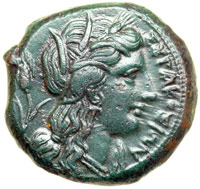 |
Sicily, Syracuse. Hiketas, 288-279 BC. AE 21. Head right of Persephone wreathed with corn; behind, corn stalk. Reverse: Galloping biga driven right by charioteer; above, star. Calciati II, p. 257, 122 (as 317-289 BC); cf. Gabrici 309. Dark green patina; Very Fine to Extremely Fine.
Sicilian bronzes are some of the most beautiful of Greek coins and often exhibit a warmth due to their having been buried in volcanic soil.
Estimated Value $400 - 500.
View details and enlarged photos
| Realized
$253 |
Lot 3034 |
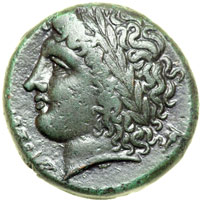 |
Sicily, Syracuse. Hiketas, 288-279 BC, AE 22. Laureate and beardless head left of Zeus Hellanios; behind head, boukranion. Reverse: Eagle standing left on thunderbolt; in left field, star and arrowhead. Cf. Calciati II, p. 302, 157 var. (without arrowhead above star); BMC 472. Very Fine.
Estimated Value $300 - 350.
View details and enlarged photos
| Realized
$184 |
Lot 3035 |
 |
Sicily, Syracuse. Pyrrhos, 278-276 BC. AE 23. Head left of Herakles wearing lion's skin. Reverse: Athena Promachos advancing right brandishing thunderbolt. Calciati II, p. 321, 176; SNG ANS 852; BMC 503; Gabrici 347. Even brown patina. About Extremely Fine.
Athena "Promachos" was Athena the "defender," most probably alluding to the defense of the city.
The bulk of the coinage under Pyrrhos, King of Epirus, was struck in Magna Graecia, comprising some of the most beautiful coins of the Greek world. In order to assist Taras (Tarentum) against the Romans, he and his general Milo accompanied a detachment of over 20,000 soldiers, along with cavalry troops and even elephants. It was these immense animals which altered the tide of the war in favor of Pyrrhos, but at such a cost that we now have the phrase "Pyrrhic victory" well ensconced in our vocabulary.
Estimated Value $450 - 550.
View details and enlarged photos
| Realized
$345 |
Lot 3036 |
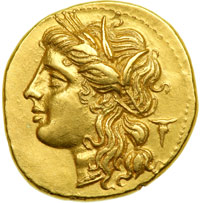 |
Sicily, Syracuse. Hieron II, 275-215 BC. Gold Drachm (or 100 Litrai; 4.2 g). Head of Persephone left with long flowing hair, wearing wreath of grain ears, single-pendant earring, and necklace; behind, boukranion. Reverse: Charioteer, holding kentron in right hand, reins in left, driving fast biga left; below horses, E. Cf. Sear 983; SNG ANS Sicily III 865 (same dies). An exceptional example and completely free from die rust. Choice Extremely Fine.
Hieron II's reign of Syracuse is of historic interest because it spanned the First and Second Punic Wars.
Estimated Value $6,000 - 7,000.
View details and enlarged photos
| Realized
$7,763 |
Lot 3037 |
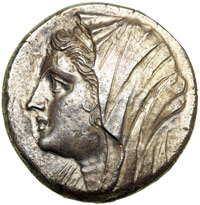 |
Sicily, Syracuse. Hieron II, 269-215 BC. AR 16 Litrai (12.96 g). Veiled head left of Queen Philistis, wife of Hieron II. Reverse: Quadriga right being driven by Nike. SNG ANS 882. Obverse porosity. Very Fine to Extremely Fine.
Estimated Value $1,500 - 2,000.
View details and enlarged photos
| Realized
$1,955 |
Lot 3038 |
 |
Sicily, Syracuse. Republic, 214-212 BC. AR 12 Litrai (10.07 g). Head left of Athena wearing crested helmet ornamented with serpent. Reverse: Artemis (Diana) standing left, discharging arrow from bow, hound running left at her feet. Cf. Boston MFA 484. Lustrous Extremely Fine.
Estimated Value $2,000 - 2,500.
View details and enlarged photos
| Realized
$1,498 |
Lot 3039 |
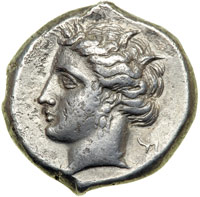 |
Siculo-Punic Coinage, c. 390-350 BC. AR Tetradrachm (16.90 g). Demeter (or Persephone) head to the left with her wreath of corn ears, wearing an elaborate triple pendant earring; behind the neck, Punic letter (M); plain border. Reverse: Horse and palm tree; the horse is walking to the left; ground-line. Gulbenkian 369 (same dies); SNG Cop (Sicily) 970 (same dies). Very rare. Very Fine.
The head has more character in that the engraver has forgotten Euainetos. The Punic letter is perhaps the initial of Machanat, 'Camp", or less likely of a mint-official.
Estimated Value $2,500 - 3,000.
Ex Gorny & Mosch Auction, Oct. 2004.
View details and enlarged photos
| Realized
$2,879 |
Lot 3040 |
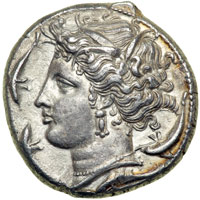 |
Siculo-Punic Coinage, c. 350 BC. AR Tetradrachm (17.3 g). Wreathed head of Arethusa left, wearing triple-pendant earring and necklace; four dolphins swimming around. Reverse: Horse head left, palm tree behind; Punic "MMHNT" below. Jenkins (SNR 57) Series 3a, 188 (O-55/R-165; SNG Cop (Sicily) 979; SNG Lloyd 1638. Excellent metal and delicately toned. A gorgeous example of this popular type. Superb Extremely Fine.
Estimated Value $4,000 - 5,000.
Ex Gorny & Mosch 2005.
View details and enlarged photos
| Realized
$13,800 |
Lot 3041 |
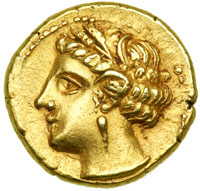 |
Siculo-Punic Coinage, c. 350-320 BC. Gold Fifth Shekel (1.52 g). Head of Tanit left wearing wreath of grain and leaf. Reverse: Horse standing right on exergual line, head reverted. Cf. Jenkins & Lewis plate 9, 240 (Group IV), also cf. Group III; Dewing 985. Rare. A few marks at reverse edge. Extremely Fine.
Estimated Value $3,000 - 4,000.
View details and enlarged photos
| Realized
$2,990 |
Lot 3042 |
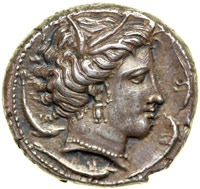 |
Siculo-Punic Coinage. Entella. AR Tetradrachm (16.66 g) struck c. 345-315 BC. Head right of Arethusa; around, four dolphins. Reverse: Horse prancing right in front of palm tree. Jenkins 132 (O44/R119); SNG Cop 82; SNG Lloyd 1615; SNG Lockett 1038; Boston MFA 492 (all same dies). Well struck with attractive antique toning. An outstanding specimen. Extremely Fine.
Estimated Value $8,000 - 9,000.
Ex Patrick Tan Collection; Nomos FPL 1, Winter-Spring 2008, lot 6.
View details and enlarged photos
| Realized
$5,520 |
Lot 3043 |
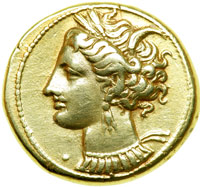 |
Siculo-Punic Coinage, 310-290 BC. Electrum Stater (7.49 g). Bust left of Tanit (Persephone) wreathed with grain, wearing necklace and triple-drop earring; in lower left field, pellet. Reverse: Horse standing right on exergual line with three small pellets underneath. Jenkins and Lewis (Carthaginian Gold and Electrum Coins) Group V. Moderately polished. Lovely style. About Extremely Fine.
This issue was debased and gold content reduced to 55-60 per cent.
Estimated Value $1,000 - 1,300.
View details and enlarged photos
| Realized
$2,185 |
Lot 3044 |
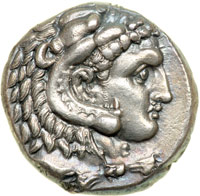 |
Siculo-Punic Coinage. AR Tetradrachm (16.89 g) minted c. 300-290 BC. Head right of Melqart-Herakles wearing lion's scalp. Reverse: Horse's forepart to left; to right, palm tree; underneath horse, inscription "People of the Camp". Jenkins (SNR 57) Series 5a; SNG Cop 983. A few pin-prick marks on reverse. Nicely toned. Extremely Fine.
Estimated Value $2,500 - 3,000.
View details and enlarged photos
| Realized
$2,645 |
Lot 3045 |
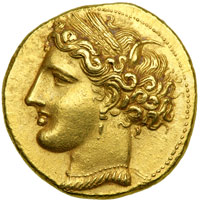 |
Siculo-Punic Coinage, c. 264-260 BC. Gold Trihemistater (12.46 g). Head of Tanit left wearing wreath of grains and leaf. Reverse: Horse standing right on exergual line, head reverted. Jenkins & Lewis plate 17, 386 (these dies; Group IX); de Luynes 3749 (these dies). Beautiful style and well struck; lustrous Superb Extremely Fine.
Likely from the hoard found at Tunis, 1948.
Estimated Value $30,000 - 40,000.
View details and enlarged photos
| Realized
$29,900 |
Lot 3046 |
 |
Macedon, Mende, c. 450-425 BC. AR Tetradrachm (16.95 g). Dionysos holding kantharos and reclining left on back of donkey. Reverse: Circular disk with sixteen-rayed star; in each corner, a grape cluster flanked by trefoils; all within a thick linear square, around which is ethnic. Noe (ANS NNM 27, "The Mende/Kaliandra Hoard") Group III (cf. 86 for probably this obverse die); SNG ANS 348. Overstruck on an earlier coin. Quite porous. Very Rare. Sharpness of Very Fine or better.
Estimated Value $800 - 1,000.
Ex Goldberg Auction 55, lot 27; Ex Malter Auction XLVII (4/11/92), lot 56.
View details and enlarged photos
| Realized
$846 |
Lot 3047 |
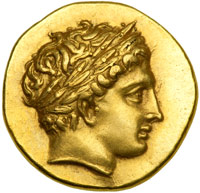 |
Kingdom of Macedon. Philip II, 359-336 BC. Gold Stater (8.55 g) minted at Pella, 340-328 BC. Laureate head right of Apollo. Reverse: Charioteer driving biga right; in lower right field, thunderbolt. Le Rider Pella II (plates 55-57). Signs of burnishing. Unusually broad flan. Extremely Fine.
Estimated Value $3,000 - 3,500.
View details and enlarged photos
| Realized
$2,875 |
Lot 3048 |
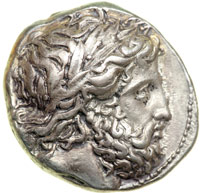 |
Kingdom of Macedon. Philip II, 359-336 BC. AR Tetradrachm (14.40 g) minted at Pella, 359-334 BC. Laureate head right of Zeus. Reverse: Philip II on horseback left, wearing kausia; below horse, monogram. Le Rider Pella IA, 77. Fine style. Rare reverse type. About Extremely Fine.
Commemorates the victory of King Philip II at the Olympic Games.
Estimated Value $2,500 - 3,000.
View details and enlarged photos
| Unsold |
Lot 3049 |
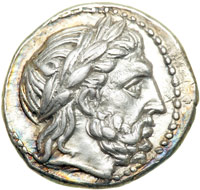 |
Kingdom of Macedon. Philip II, 359-336 BC. AR Tetradrachm (14.06 g) minted at Pella c. 336-328 BC. Laureate head right of Zeus. Reverse: Youth on horseback right, holding palm; in lower central field, dolphin. Le Rider Pella II. Extremely Fine.
Estimated Value $1,200 - 1,500.
View details and enlarged photos
| Realized
$989 |
|
|